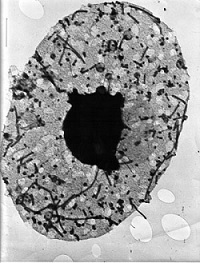 |
| Electron microscope image of the influenza virus--Courtesy of Olga Fišerová |
For the first time since the swine flu pandemic in 2009, influenza A virus pdm09 (pH1N1) predominated in the U.S. during the 2013-2014 flu season. And while this season saw overall lower levels of outpatient illness and death than in those predominated by fellow A virus H3N2, for older adults it was comparatively more severe, a CDC report found.
According to the center's June 6 Morbidity and Mortality Weekly Report, pH1N1 caused higher rates of hospitalization among adults aged 50-64 compared with recent years. The report's authors pinned that group's incidence of hospitalization--"well above the range of rates seen in seasons following the pandemic"--on lower flu vaccine coverage, among other factors, but the CDC also warned that all populations are vulnerable.
"This season is a reminder that influenza viruses can affect all ages and that yearly vaccination is the best step to take to prevent illness from influenza and its associated complications," it said in a release, as quoted by Medscape.
Like last year, the FDA recommends that next season's vaccines cover both H1N1 and H3N2, its Vaccines and Related Biological Products Advisory Committee said in late February. 2014 to 2015 influenza vaccines in the U.S. should maintain the same compositions as in 2013 to 2014, comprising the A/California/7/2009-like (2009 H1N1) virus, an A/Texas/50/2012-like (H3N2) virus, and a B/Massachusetts/2/2012-like (B/Yamagata lineage) virus.
In addition to the trivalents' strains, quadrivalent vaccines should contain a B/Brisbane/60/2008-like (B/Victoria lineage) virus, according to the agency. Those vaccines, introduced for the first time last year, have so far proved lucrative for their makers: In last year's fourth quarter, flu vaccine sales were up 56% at AstraZeneca ($AZN), 76% at GlaxoSmithKline ($GSK) and 94% at Sanofi ($SNY), the only three companies to manufacture quadrivalents.
- read the report
- get more from Medscape (reg. req.)